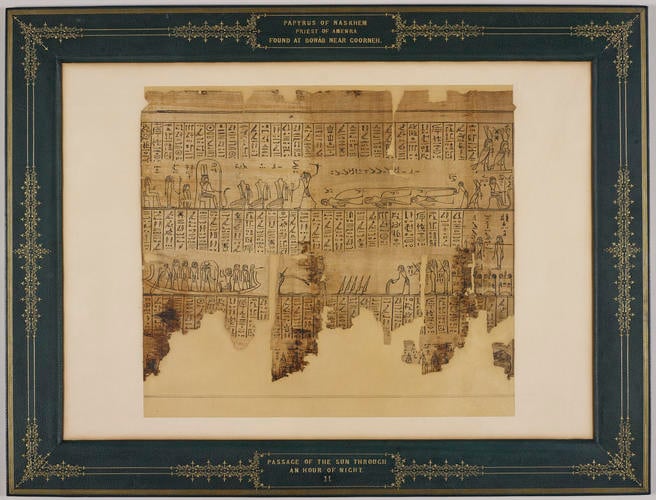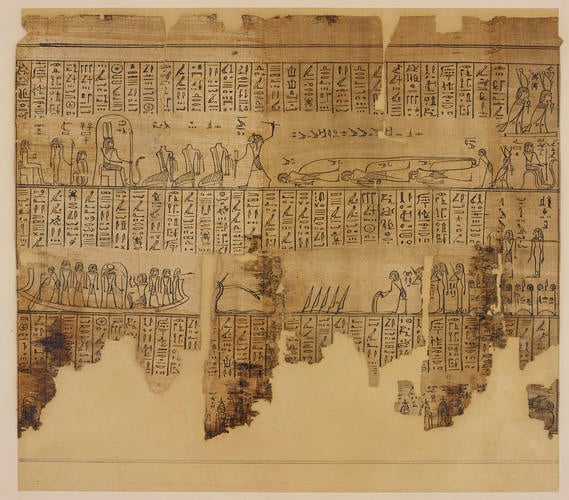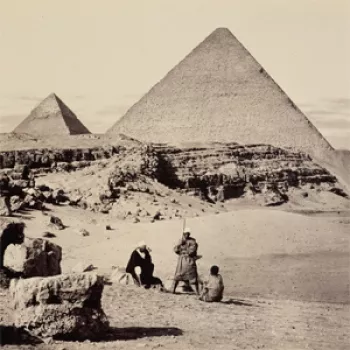Section of the papyrus belonging to Nesmin, with the seventh hour of the Amduat c.300-275 BC
61.5 x 80.5 cm (mount) (whole object) | RCIN 1145260
-
Section of the papyrus belonging to ‘God’s Father and Prophet of Amun-Ra, King of the Gods, Nesmin, born of the Lady of the House, Sistrum-player of Amun-Ra, Tasherit(en-ta)ihet’ with the seventh hour of the Amduat (see also RCINs 1145259-66).
The Amduat (literally ‘that which is in the netherworld’), also known as the Book of the Hidden Chamber, is a funerary text that describes the journey of regeneration of Ra, the Egyptian sun god, through the 12 hours of the night from sunset (symbolising death) to sunrise (symbolising rebirth). The text starts appearing in royal tombs from around 1500 BC, and the two most notable examples are perhaps those painted on the walls of the burial chambers of Thutmose III (1479–1425 BC) and Amenhotep II (1427–1400 BC) in the Valley of the Kings, Thebes. It represents an important stepping stone in the literary tradition of ancient Egypt, being the model for later Books of the Afterlife, and it maintains its relevance well into the Graeco-Roman era.
The main aim of the text is to offer a description of the netherworld so that the deceased, as well as the living, are able to gain familiarity with what to expect when their journey into the afterlife begins. Knowledge of the secret paths of the netherworld offers protection to the deceased from the dangers and threats he/she may encounter; the text shows the obstacles and demons that could obstruct a safe passage through the hereafter as well as the deities and beings able to assist and help the deceased towards the completion of the journey of regeneration.
In the seventh hour, Ra is faced by the most terrifying being of the whole netherworld: Apophis, the great serpent which blocks the passage of the sun god's barque (Mesektet) on the middle register by swallowing up the waterway. Embodiment of chaos and evil, the snake-god represents the principal threat to the nocturnal journey of the sun god and even the powerful Ra is frightened by him. Nowhere else in the whole netherworld is the sun god in a more vulnerable position and he is therefore in need of help from other deities to successfully overcome his most hostile and terrifying enemy. One of them is Osiris, depicted on the upper register seated on a throne, protectively encircled by the serpent Mehen. Osiris is shown here in his role of judge (and punisher) of the dead with three decapitated bodies kneeling in front of him and the corpses of three other lying further along. These obviously failed Osiris's judgement while three others gained the status of 'blessed dead' and their 'ba'-soul (indicated as a bird with human head) is depicted at the right-hand side of the register, accompanying the god Atum (or, according to some, Ra in the form of Atum), depicted sitting on the coil of a snake. The sun god is also present in three different forms behind Osiris's throne. On the lower register, quite lacunose in this papyrus, another important god is also included in the seventh hour: the hawk-headed Horus. He is accompanied by a large group of standing deities, all bearing a star over their head: twelve male figures (star-gods) and twelve female ones (goddesses of the hours). On the right-hand end of the register, a crocodile is depicted on top of a mound guarding the head of Osiris.
The middle register contains Ra's solar barque but the god is depicted this time not in his usual shrine but, exactly as Osiris on the upper register, encircled by the serpent Mehen, who will also protect the sun god for all the subsequent hours of the night. Protection is necessary to face Apophis but certainly not enough to defeat him and so two other powerful deities join Ra's bark to help in his struggle against the evil serpent: Isis and Set. Isis is Osiris's wife and sister and she is the one who, after Set killed and dismembered him, collected his body parts and gave him a new life. She is a great healer and a goddess of life and love who can, such as in this case, also display an aggressive and fighting nature. In the papyrus she is depicted stretching her arms towards Apophis, using her magic powers to enchant him. The other helping deity is depicted as a male figure, called the 'Eldest Magician', that has been identified as Set. It may perhaps surprise to find him on the solar barque, next to Isis, assisting Ra in defeating Apophis. Set was in fact a god usually associated with chaos and evil (exactly like Apophis) and he was indeed the one who killed Osiris and subsequently engaged in a long battle against Horus. Nevertheless Set, perhaps exactly because somehow very similar to Apophis, is chosen to help defeat the evil serpent. In other texts, Set is shown engaging in a physical struggle with Apophis, battling him with his lance from the prow of the solar bark to make him regurgitate the waters he had swallowed. In the Amduat, though, both Isis and Set use magic to enchant him while other deities apply chains and ropes on the serpent, slaughter him and cut him with knives 'to punish Apophis in the netherworld, day after day.'
Egyptologist Samuel Birch published his study of the papyrus in 1863 (RCIN 1079232). A facsimile was published in 1913 with the hieroglyphic transcripts, translations and an introduction by E.A. Wallis Budge.
A more recent English translation of the complete text of the Amduat can be found in Hornung, E and Abt, T eds, 2007. The Egyptian Amduat. The Book of the Hidden Chamber. Zurich: Living Human Heritage, while a psychological interpretation of the text is presented in Schweizer, A, 2010. The Sungod’s Journey through the Netherworld. Reading the Ancient Egyptian Amduat. Ithaca, NY and London: Cornell University Press.Provenance
Excavated in Egypt at the Dra' Abu el-Naga' necroplis, near Deyr el-Bahri, part of the larger Theban necropolis, 1862 by Mustafa Aga Ayad, consular agent to the United Kingdom. Acquired by King Edward VII, when Prince of Wales, during his 1862 tour of the Middle East.
-
Measurements
61.5 x 80.5 cm (mount) (whole object)
36.2 x 46.6 cm (sheet of paper)
86.5 x 67.0 cm (book in box)
Category
Alternative title(s)
Passage of the sun through an hour of the night ; 2. (Papyrus of Nas-Khem Priest of Amen-Ra).











